It has been a few months past 2 years, so the second iteration of this tank was undone. Previous journal.
Issues with the previous setup: too much jungle, hard to make maintenance, I didn't trim the anubias and it got out of control, many plants pressed against the glass because of all the stone hardscape, I couldn't grow most plants, the soil quickly spread everywhere out of where wanted it to be, mixing layers and all that, most areas had a very thin soil as a consequence and I couldn't get the plants to stay rooted. The use of polystyrene to add volume became a headache when the roots entangled with it and pulled everything out of place. I think overall the light was too weak, the CO2 level was all over the place.
And once more, too much jungle, the wife didn't like it. (I did and the fishes looked like they did too, but... priorities).
The transition to the new layout was a mess and the house looks like a war zone. But overall things went according to plan and I'm now where I thought I'd be. Like I did during the first rescape, I did a 2-weeks dark start. It worked well the first time, let's see how it goes now. But that means that all the fishes and the plants need to be kept somewhere for 2 weeks. The first time, I did this during "winter" because of vacations, and there was a lot of stress for me and the fishes with the water quickly dropping in temperature while I moved the fishes around. I also kept them in my 90L water change bucket with the canister running, and it was far from ideal, and I couldn't really see anything in there. This time I followed the weather forecasts closely and found this 2 weeks break from a series of cold fronts that were hitting us. I bought a 200L kids swimming pool (one with no inflatable parts) and it worked as a temporary house. Did it work? Yes. Did the fishes like it? Hell no. But I think the biggest issue was that I was so afraid that the fishes would jump, that I kept the level very low. I now see how being at a low level could be perceived as a danger for the fishes, a trigger to swim away to other bodies of water. They were permanently on the edge, darting away and crashing against the pool sides with any movement in their room. On the bright side, no fishes jumped out, not even the hatchetfishes.
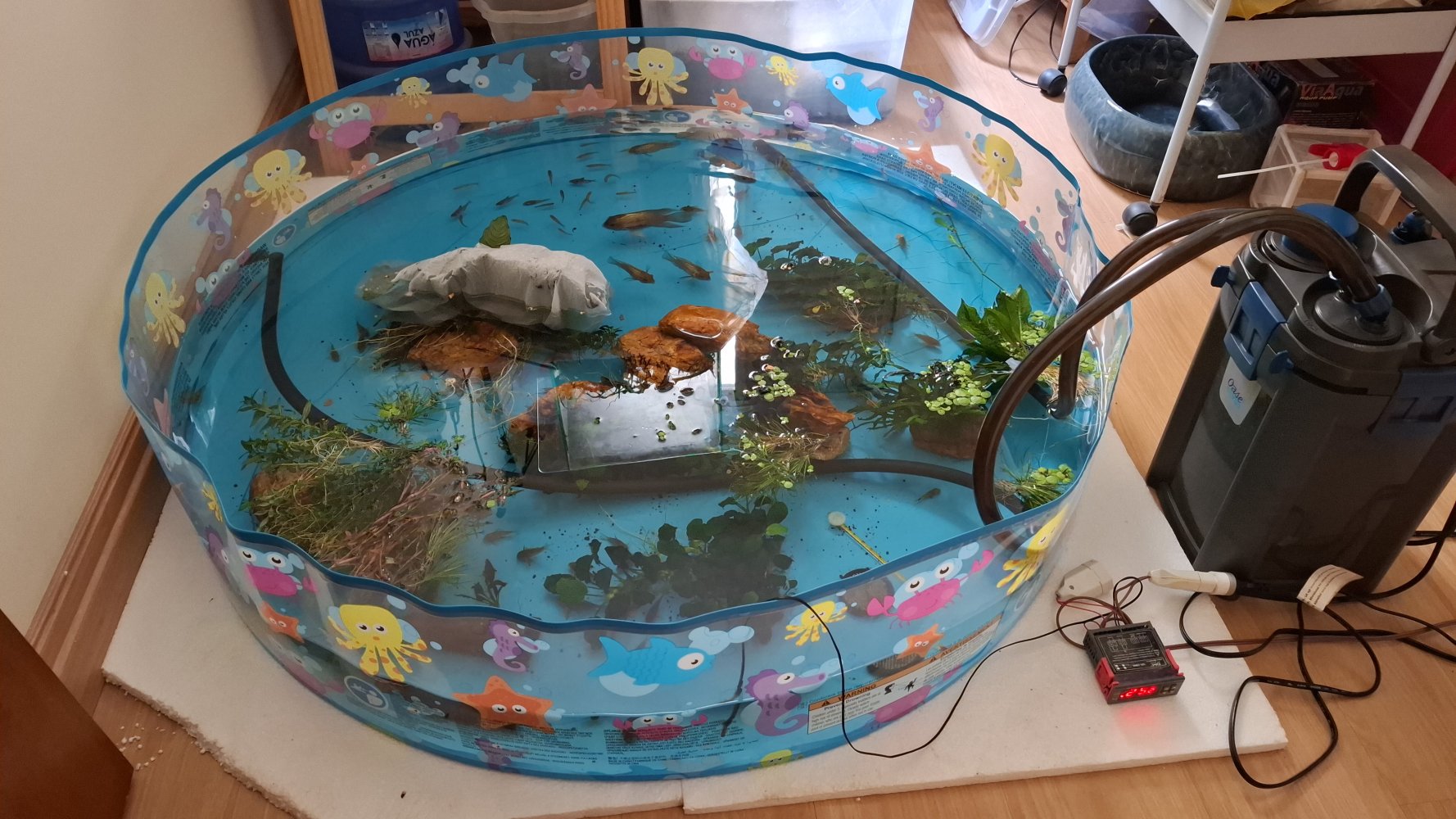
The plants weren't exactly in prime conditions, and their time floating in the pool didn't do them any favor. I gave away 90% of the plants, including almost all the anubias.
Anyways, like I mentioned somewhere, the idea was to make a cleaner layout. I adapted an idea that I saw in a picture once (and never again, as I lost the picture) of having a nice vase inside the tank and have it planted, with the surroundings as bare sand. It was a much smaller tank, it had a single beta in it, but my idea was to replicate it and add a nice eleocharis carpet around the vase. Mostly because I never had one and I wanted the experience. Finding a suitable vase was actually much harder than expected. It needed to be wide, but short, but not too shallow. And somewhat pretty. And affordable. It took me a couple of months searching, from vases, to salad bowls, fruit bowls, handmade, imported... Not a single option worked. Then I moved to sink bowls and that's where I got it! I'd have never guessed, but they were the right size and I just had to search a little to find one that wasn't boring white and/or priced for mansions.
The plan was to have only 2 vases as hardscape. I thought the fishes would miss the jungle, but I'd have to live with it. But then something unusual happened. I discovered that I can't remove my wood piece from the tank, it doesn't fit through the opening in the tank's hood. Long story short, this hood was made completely different from my specifications, but I accepted it because the guy took so long to make it and he was so late to deliver it, that I just didn't have any fight left in me. And it is bolted in a way that I fear that if I remove it, I won't be able to assemble it back into place without messing the current fit. So the wood piece stayed, and that gave me an excuse to keep one of my anubias and I'm sure the fishes will enjoy a place to hide when needed.
So fast forward 2 weeks, this past weekend I removed all the water, planted my assorted emerged grown new plants and the almost dying old plants, a million bits of eleocharis, filled it back up, moved the fishes back and it's done! Of course this single line took over 12h of dedicated work to get done, but I'm sure most are familiar with this kind of thing.
In the mean time, I changed the lights, their positions, moved away from the Finnex fixtures (I will use them again when I make a smaller tank) and kept the 2 50W 5000K industrial fixtures and the 2 35W Chinese indoor growth blurple fixtures. Right now the white fixtures are "dimmed" with black tape to ~60% light. I built, tested, fixed, tested, fixed (many times) my DIY horizontal reactor. The conclusion is that I suck at DIY. In the end, it is still leaking, but instead of trying to fix it, I'll just collect the water and pump it back into the tank. It is roughly a drop per minute, half a cup per day. I like this reactor concept, but time will tell if it works for me.
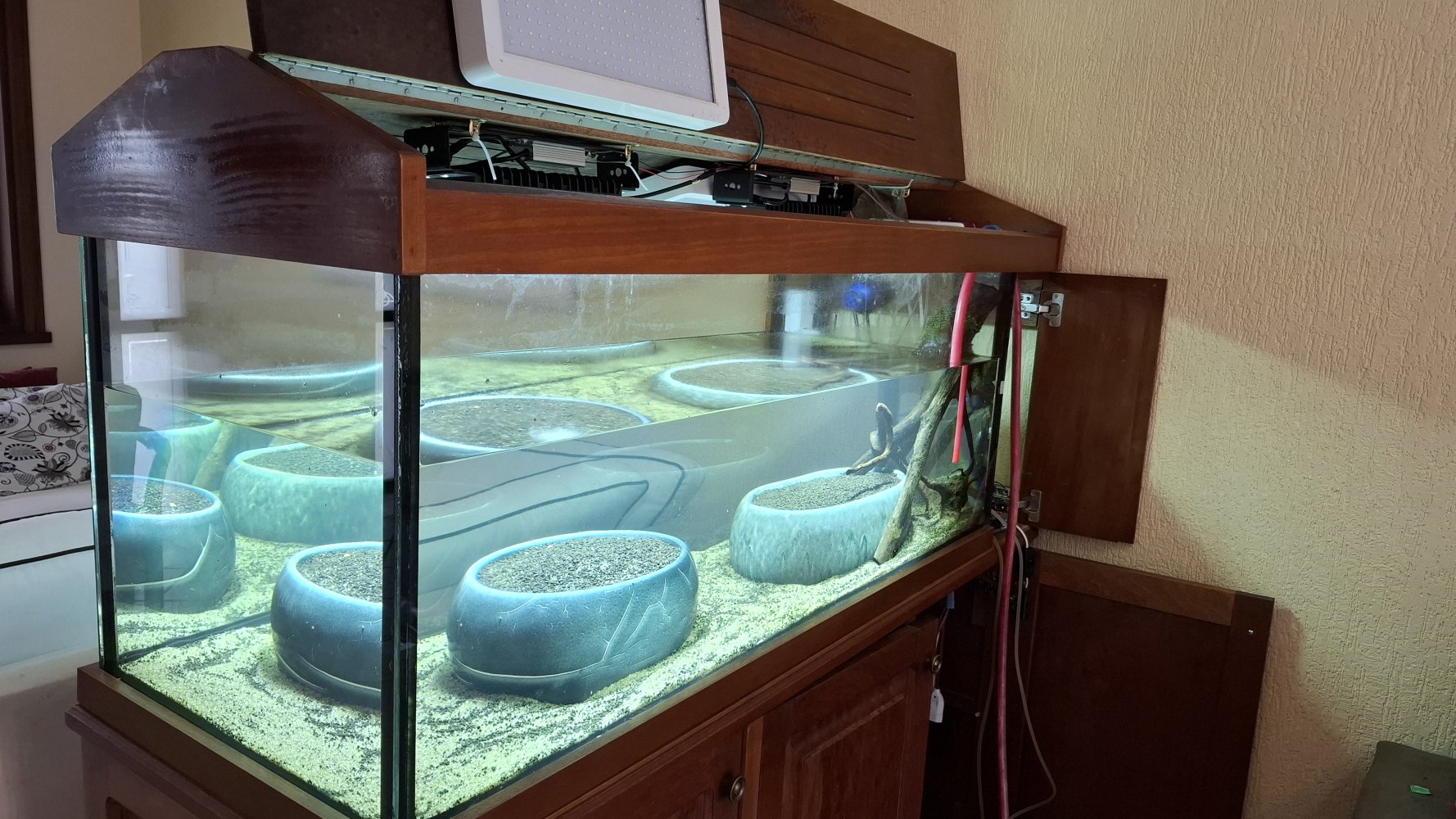
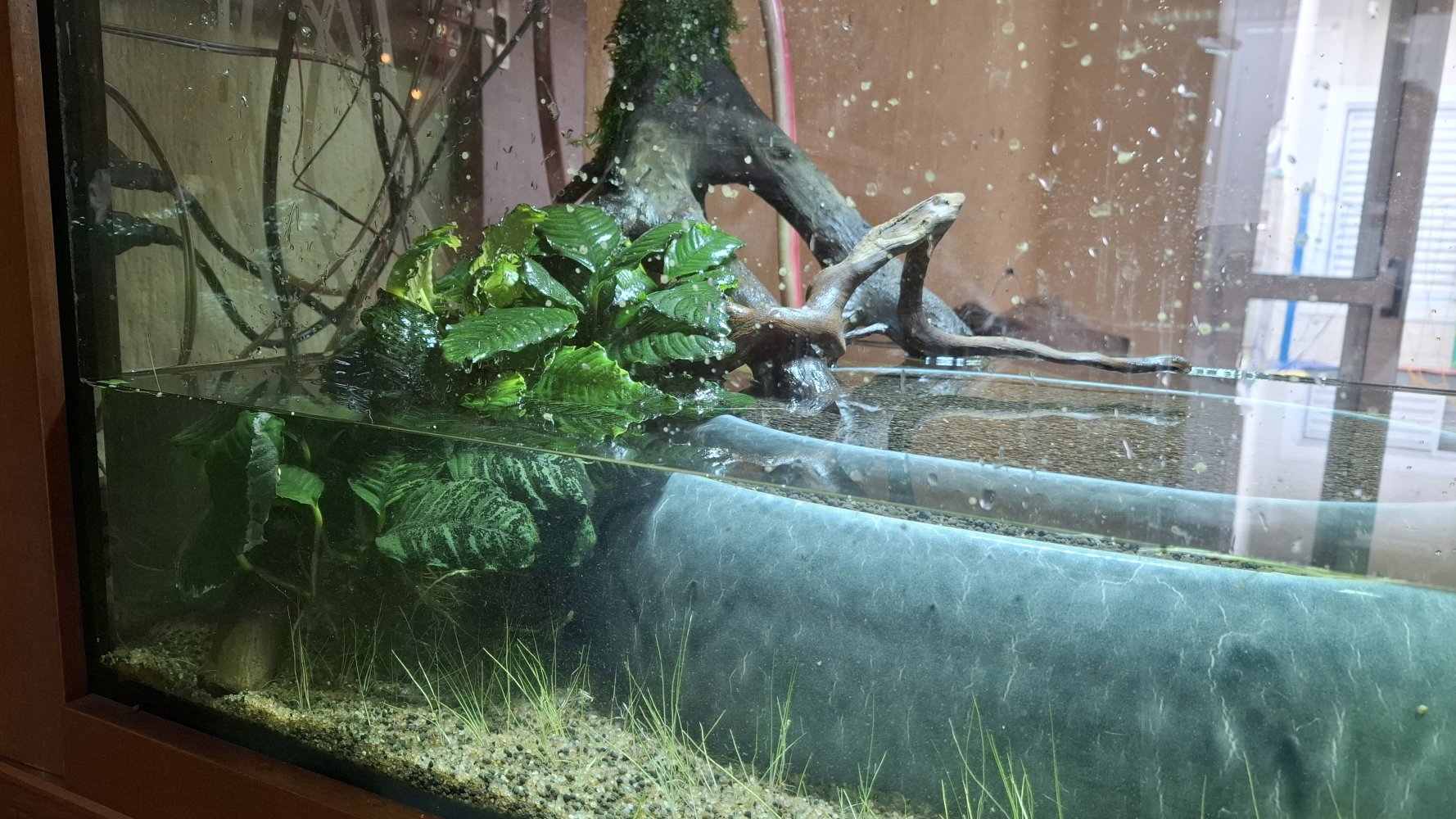
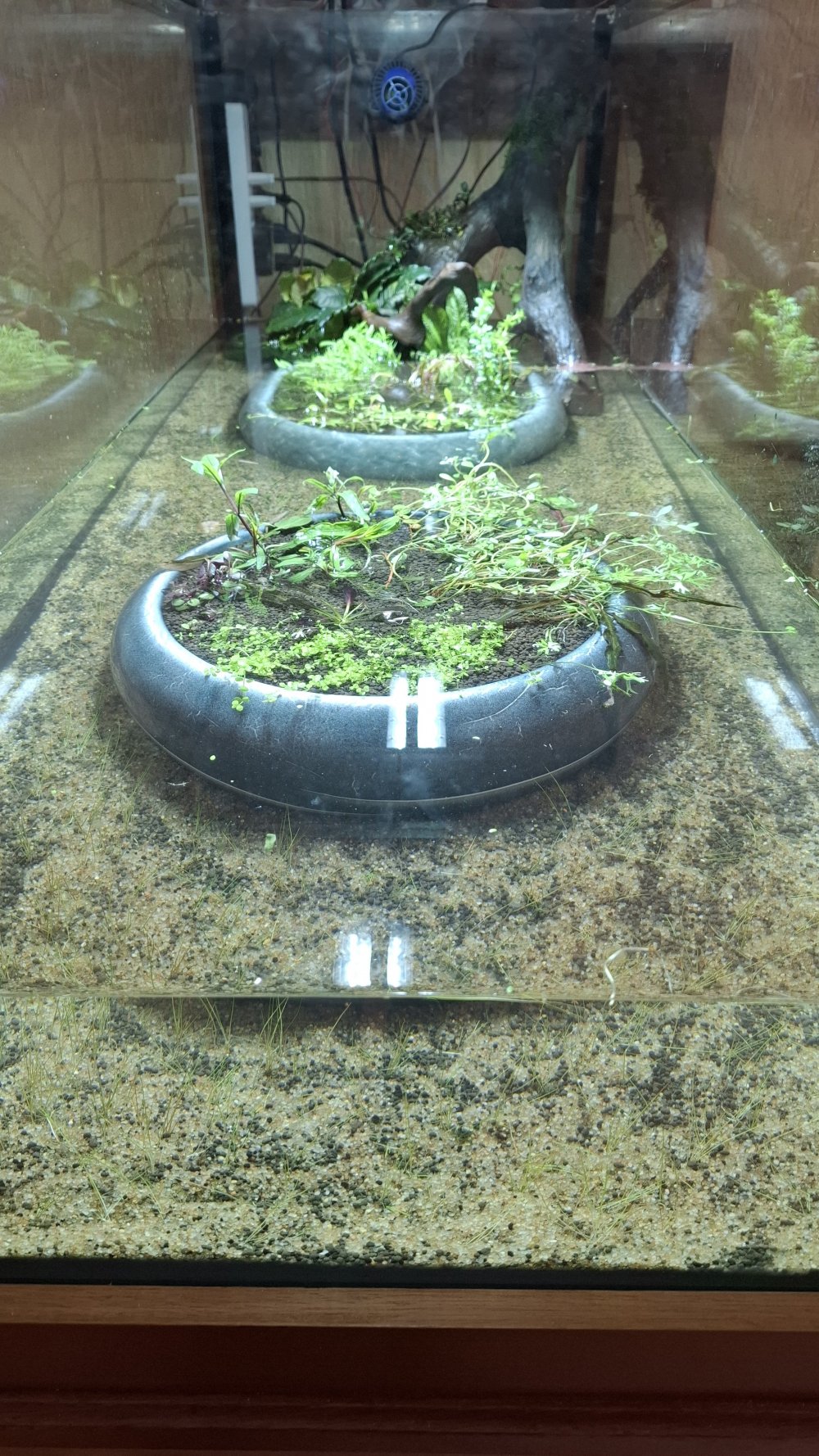
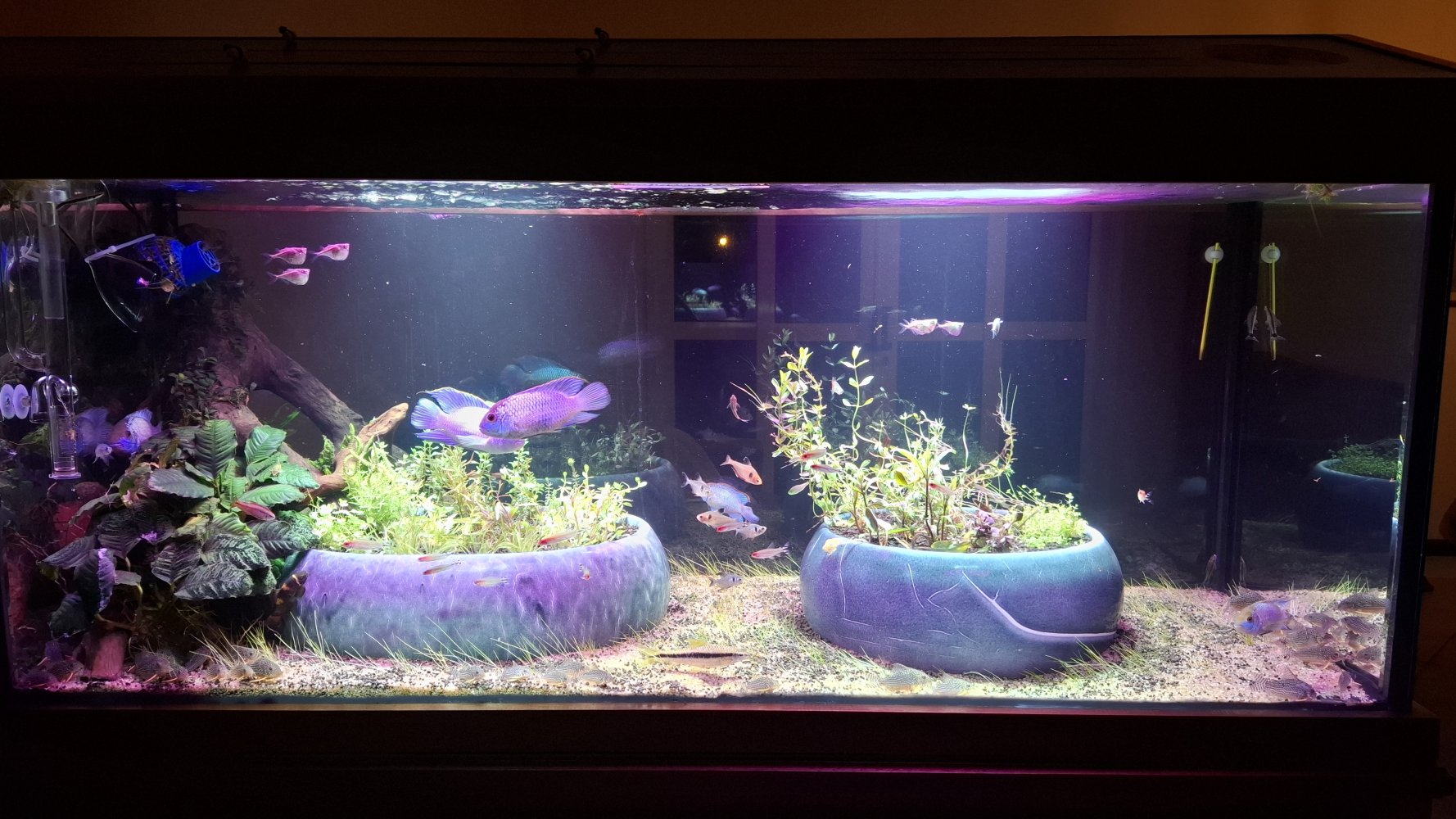
First impressions are that I got carried away and bought too many plants for the very limited space I got to grow them in, using the vases. But this is a good thing. If I can't control myself, the limited room will. And I'm sure some plants won't adapt, so it will be a survival of the fittest kind of situation. And if they all grow? I'll figure something out. Another first impression is that I have way more fishes than I thought. It shouldn't be a surprise, but it was much harder to see the fishes in the jungle. I had been thinking of what new fishes I would add to the layout, but now I think I'll just keep the ones already there. Oh, I sold 2 of the 4 L075 plecos. I figured that the new layout wasn't very pleco friendly.
I mentioned in the previous journal that every now and then I would find some sterbai cory babies. When I searched the tank I thought that I had maybe 15 cories, so considering the jungle factor that was probably ~20 cories. This experience allowed me to get a precise figure of 43 cories. And now, without the jungle, they look like a 43 cories shoal. And it got me thinking... who in their right mind tries to grow a dense eleocharis carpet with 43 cories?
Oh, and as a final note, the wife said it looks much better than before. So mission accomplished.
Issues with the previous setup: too much jungle, hard to make maintenance, I didn't trim the anubias and it got out of control, many plants pressed against the glass because of all the stone hardscape, I couldn't grow most plants, the soil quickly spread everywhere out of where wanted it to be, mixing layers and all that, most areas had a very thin soil as a consequence and I couldn't get the plants to stay rooted. The use of polystyrene to add volume became a headache when the roots entangled with it and pulled everything out of place. I think overall the light was too weak, the CO2 level was all over the place.
And once more, too much jungle, the wife didn't like it. (I did and the fishes looked like they did too, but... priorities).
The transition to the new layout was a mess and the house looks like a war zone. But overall things went according to plan and I'm now where I thought I'd be. Like I did during the first rescape, I did a 2-weeks dark start. It worked well the first time, let's see how it goes now. But that means that all the fishes and the plants need to be kept somewhere for 2 weeks. The first time, I did this during "winter" because of vacations, and there was a lot of stress for me and the fishes with the water quickly dropping in temperature while I moved the fishes around. I also kept them in my 90L water change bucket with the canister running, and it was far from ideal, and I couldn't really see anything in there. This time I followed the weather forecasts closely and found this 2 weeks break from a series of cold fronts that were hitting us. I bought a 200L kids swimming pool (one with no inflatable parts) and it worked as a temporary house. Did it work? Yes. Did the fishes like it? Hell no. But I think the biggest issue was that I was so afraid that the fishes would jump, that I kept the level very low. I now see how being at a low level could be perceived as a danger for the fishes, a trigger to swim away to other bodies of water. They were permanently on the edge, darting away and crashing against the pool sides with any movement in their room. On the bright side, no fishes jumped out, not even the hatchetfishes.

The plants weren't exactly in prime conditions, and their time floating in the pool didn't do them any favor. I gave away 90% of the plants, including almost all the anubias.
Anyways, like I mentioned somewhere, the idea was to make a cleaner layout. I adapted an idea that I saw in a picture once (and never again, as I lost the picture) of having a nice vase inside the tank and have it planted, with the surroundings as bare sand. It was a much smaller tank, it had a single beta in it, but my idea was to replicate it and add a nice eleocharis carpet around the vase. Mostly because I never had one and I wanted the experience. Finding a suitable vase was actually much harder than expected. It needed to be wide, but short, but not too shallow. And somewhat pretty. And affordable. It took me a couple of months searching, from vases, to salad bowls, fruit bowls, handmade, imported... Not a single option worked. Then I moved to sink bowls and that's where I got it! I'd have never guessed, but they were the right size and I just had to search a little to find one that wasn't boring white and/or priced for mansions.
The plan was to have only 2 vases as hardscape. I thought the fishes would miss the jungle, but I'd have to live with it. But then something unusual happened. I discovered that I can't remove my wood piece from the tank, it doesn't fit through the opening in the tank's hood. Long story short, this hood was made completely different from my specifications, but I accepted it because the guy took so long to make it and he was so late to deliver it, that I just didn't have any fight left in me. And it is bolted in a way that I fear that if I remove it, I won't be able to assemble it back into place without messing the current fit. So the wood piece stayed, and that gave me an excuse to keep one of my anubias and I'm sure the fishes will enjoy a place to hide when needed.
So fast forward 2 weeks, this past weekend I removed all the water, planted my assorted emerged grown new plants and the almost dying old plants, a million bits of eleocharis, filled it back up, moved the fishes back and it's done! Of course this single line took over 12h of dedicated work to get done, but I'm sure most are familiar with this kind of thing.
In the mean time, I changed the lights, their positions, moved away from the Finnex fixtures (I will use them again when I make a smaller tank) and kept the 2 50W 5000K industrial fixtures and the 2 35W Chinese indoor growth blurple fixtures. Right now the white fixtures are "dimmed" with black tape to ~60% light. I built, tested, fixed, tested, fixed (many times) my DIY horizontal reactor. The conclusion is that I suck at DIY. In the end, it is still leaking, but instead of trying to fix it, I'll just collect the water and pump it back into the tank. It is roughly a drop per minute, half a cup per day. I like this reactor concept, but time will tell if it works for me.




First impressions are that I got carried away and bought too many plants for the very limited space I got to grow them in, using the vases. But this is a good thing. If I can't control myself, the limited room will. And I'm sure some plants won't adapt, so it will be a survival of the fittest kind of situation. And if they all grow? I'll figure something out. Another first impression is that I have way more fishes than I thought. It shouldn't be a surprise, but it was much harder to see the fishes in the jungle. I had been thinking of what new fishes I would add to the layout, but now I think I'll just keep the ones already there. Oh, I sold 2 of the 4 L075 plecos. I figured that the new layout wasn't very pleco friendly.
I mentioned in the previous journal that every now and then I would find some sterbai cory babies. When I searched the tank I thought that I had maybe 15 cories, so considering the jungle factor that was probably ~20 cories. This experience allowed me to get a precise figure of 43 cories. And now, without the jungle, they look like a 43 cories shoal. And it got me thinking... who in their right mind tries to grow a dense eleocharis carpet with 43 cories?
Oh, and as a final note, the wife said it looks much better than before. So mission accomplished.
Last edited:























